By H. Paladino / Burma Link
An epidemic of drug addiction is destroying communities and claiming a generation of young people and scores of men in Kachin State and northern Shan State, embattled ethnic areas of Burma.
Opium cultivation in ethnic conflict zones has steadily increased during the recent years and addiction among ethnic civilians has spiraled out of control. For some ethnic armed groups such as the Ta’ang National Liberation Army (TNLA) in northern Shan State, traditional Ta’ang (also called Palaung) lands have become battle fields not only to fight against the Burmese military but also to fight against the drugs.
Two different ethnic women’s organizations, Kachin Women’s Association Thailand (KWAT) and Palaung Women’s Organization (PWO), have published comprehensive reports about the crisis. The recent KWAT investigation “Silent Offensive” found half of all youth in some Kachin regions use drugs, primarily heroin. The PWO’s 2011 report “Still Poisoned” found poppy cultivation to have more than tripled in 15 Ta’ang villages from 812 acres to 2740 acres between 2006 and 2011. In one village, addiction rates among males aged 15 and over skyrocketed from 44 to 91 percent between 2009 and 2011.
The crisis is inextricable from the conflict between ethnic armed groups and the Burmese military. In Kachin State and northern Shan State, the Burmese military is waging an offensive war, attacking ethnic armies and civilians, seeking to control access to precious natural resources, snatching up valuable fertile land, and building new military camps in an attempt to expand their control over ethnic lands. Ethnic civilians in these areas now suffer the consequences of not only the conflict and the military abuse, but also a drug epidemic of a scale unimaginable to anyone who doesn’t call these areas their home.
Instead of tackling the problem, the (military) government reaps multiple benefits from the drug crisis that provides both an effective weapon of war against ethnic resistance and a lucrative business.
The role of the government
According to a Kachin villager quoted in “Silent Offensive,” just one kilogram of opium can bring in nearly five hundred U.S. dollars. Poppy fields in his village fall under the protection of the government-backed Border Guard Forces (BGF), who collect steep taxes from villagers rather than combat the nominally illegal drug trade.
The Burmese police and forestry department also collect taxes, making it difficult to earn a living even with the high value of the drug, the same villager says. Proxy militias and the BGF also capture drug revenue by either growing, producing, or trafficking opiates or methamphetamine, in addition to taxing and providing security to others doing so, according to the KWAT report.
Proxy militias carry out the same practices in northern Shan State, too. A noted TNLA leader Tar Aik Bong told Burma Link, a Mae Sot-based NGO, that “the Burmese troops have allowed its militias to plant opium and trade drugs for a long time.” He also shared pictures from a May 2014 TNLA raid of a Burmese proxy militia camp near Namkham Township in northern Shan State, which yielded several kilos of what appears to be heroin, 20 small bags of methamphetamine, and stacks of cash.
While the government claims to be tackling the issue, ethnic Kachin and Ta’ang organizations assert the opposite. Moon Nay Li, the KWAT coordinator, told Burma Link that “According to our research, KIO/KIA (Kachin Independence Organization/Army) strongly do anti-drug campaign yearly and
Echoing the local voices, Bertil Lintner, a long time Burma specialist and author of “Burma in Revolt: Opium and Insurgency since 1948,” told Burma Link; “The government has never done anything to combat drugs, it’s a total lie.”
Opium is a cash crop and, according to Bertil Lintner, thrives in conflict situations because the buyers come directly to the villages. With the help of the conflict, poppy has now become an integral to the local economy. Since poppy is easy to grow and sell, it has increased tremendously in popularity over staple crops such as rice, corn, and tea in war-torn areas.
In Kachin areas, the internally displaced persons (IDPs) numbering over 100,000 provide opium farmers a wealth of cheap labour to work at the poppy fields. In Ta’ang areas, traditional reliance has been on a crop they can no longer afford to grow and sell. The Ta’ang are known for their tea, the price of which has plummeted since 2006. According to the PWO’s 2011 report, “The Burmese regime exercises total control over the local economy, including the tea industry, which is the traditional livelihood of the Palaung (Ta’ang) people. As the price of tea plummets, the price of essential goods such as rice has increased; many Palaung (Ta’ang) can therefore no longer rely on the tea industry to make ends meet.” The opium business, perhaps not by accident, has become an important means by which to scrape by a living.
Poppy and politics
In the 2010 elections, local politicians in Kachin and Shan States used impunity for poppy cultivation to secure votes from economically hard-pressed villagers.
In the Kachin State, after the Burmese military-backed Union Solidarity and Development Party (USDP) member and leader of the BGF, Zakhung Ting Ying, won a seat in the parliament, the villagers in Chipwi and Waingmaw have been allowed to grow opium freely. Ting Ying’s BGF troops not only tax and protect the opium fields but they assist the Burmese military to wage war against the KIA, according to the KWAT report.
Same pattern manifests in Ta’ang regions. Burma Link spoke with De De, a staff member at the PWO, who explained that a well-known drug lord ‘Pansay’ Kyaw Myint, also a member of the USDP, promised voters freedom to grow opium for five years in exchange for votes. In the area of Namkham Township, a major Ta’ang town, opium cultivation increased by 4,000 acres in just one village in 2010, the year Kyaw Myint was elected to office. Like Zakhung Ting Ying, Kyaw Myint is also the head of a local militia that protects and taxes the poppy fields and fights against the ethnic armies.
Burma Link also spoke with two TNLA soldiers, Mai and Mai Main, who had come to study human rights and law in Mae Sot. “Pansay Kyaw Myint is, he’s the leader of like public army, like cooperates with the Burma government. So, his area is around Namkham Township. So, he has power, he has power to grow opium. So, now also our TNLA fights against him, not to grow,” Mai Main said.
Villagers also accuse Kyaw Myint of allowing dealers to operate with impunity so they can arrest addicts and extort money from them for their release. The Burmese police, to them, are interested in profiting from the crisis, not working to uproot and end it. The effects are dire. “Most young people are using drugs. Now our people are almost all gone,” said De De with deep sadness.
In fact, the crisis in Ta’ang land is such that it’s solving accounts for half of the Palaung State Liberation Front (PSLF) and TNLA objectives. Tar Aik Bong, a leader in these two organizations, explained the situation in a recent interview with Burma Link:
“The main aims of PSLF/TNLA are to attain national equality and self-autonomy, but, due to the current increasing in opium plantations and drugs smuggling and drug addiction issues in the region, the TNLA has to operate these two objectives jointly: a war on drug eradication and, at the same time, national liberation.”
Anti-drug campaigning
To cope with the crisis, the TNLA operates remote drug rehabilitation centers in the area’s forests and conducts anti-drug educational campaigns, according to the TNLA soldiers Mai and Mai Main. Their efforts to post anti-drug posters in urban centers in northern Shan State, they say, are thwarted by Burmese police, who tear them down. Additionally, the Burmese military and their local proxy militias fight the TNLA whenever they are on drug eradication missions or educating villagers about the dangers of drugs, Mai and Mai Main explain.
The role of the government’s anti-drug teams is highly contentious. A Ta’ang villager quoted in the PWO report “Still Poisoned”, explains that opium farmers have to pay taxes not only to the police, militia, and Burmese military soldiers, but even the government anti-drug teams. According to the same report, the government’s anti-drug teams only eradicate a few poppy fields that are next to roads and easily visible, leaving most of the fields untouched. Farmers were also reportedly able to bribe the anti-drug teams to have their fields left undamaged. “They (the government) don’t do anything [to stop it]. Even themselves, they use it. How can they control the people?” De De asks.
Mai also explains that the anti-drug teams are very selective in their eradication methods that they, Mai says, conduct for show. “…in 2009 when they came in our village, they came for destroying poppy field, but I noticed what they said; ‘destroy all of not very good poppy fields. Leave good poppy fields,’” said Mai who at the time had not yet joined the TNLA but soon joined to help his people.
Bertil Lintner also repeatedly contested the government’s role: “I am not saying necessarily the government is behind it but they’re certainly not doing anything about it. They are not doing anything about it because it suits their policies.”
Indeed, in the contested ethnic areas, it is easy to see how the drug trade can provide an all-round beneficial situation for the government; it provides a lucrative business, weakens armed opposition, and systematically destroys ethnic communities thus preventing any future opposition movements.
Problem in full bloom
“Before you could ask one question: ‘How many people are using drugs?’ Now you cannot ask that question. You will have to ask the opposite one: ‘Who are not using drugs?’”, De De said.
“[It’s] everywhere. That is the most challenging thing. That is worse than the fighting,” she continues. As an increasing number of villagers, mostly males, struggle to support their addictions, it is the women in both Kachin and Ta’ang communities who shoulder the burden of caring for the addicts. Wives, mothers, and sisters of addicts often must not only provide for the family and support the user’s habit, but they suffer severe physical and mental abuse from them, particularly if they are unable or unwilling to support the addiction.
In the Kachin State, heroin crisis is rampant even in urban areas and among youth on university campuses. It has also become commonplace in the mines. The KWAT report found rates are as high as 90 percent in mining areas, where migrants come for work, get hooked on methamphetamine or heroin, and must stay in the mines just to feed their new addictions. These areas attract men starved for economic opportunity, who flock to the mines for work, partake, perhaps, in casual drug use, and before long get roped into a gripping addiction.
The spread of HIV/AIDS is a growing concern, too. Users often try smoking opium or heroin before intravenous use. When they become hooked, they switch to injecting, the more cost-effective method of consumption. As users carelessly share needles, they risk contracting the terminal disease. Numbers on the growing HIV/AIDS problem are scant. KWAT cites one health worker from Muse, close to the China border, saying that of the 150 infected in her community, 50 had already died of the disease.
Some needle-exchange programs are now being operated by foreign NGOs in an attempt to combat the crisis. These programs, it seems, are among the very few allowed to be operated by the military government. Areas where the drug crisis is at its very ugliest are generally not accessible to international organizations due to security concerns and government restrictions.
Among these hindered organizations is The United Nations Office on Drugs and Crime (UNODC), a global authority on data on illicit drug trends. The UNODC has come under sharp criticism by KWAT, the PWO, and others, for its partnership with the Burmese government, who these groups view to be profiting from and even encouraging and exacerbating the crisis.
The UNODC collaborates with the Burmese governmental agency the Central Committee for Drug Abuse Control to implement the Myanmar Opium Survey. The survey estimates poppy cultivation, opium yield, and sociological components in some or all areas of the northern Shan State, Kachin State, Chin State, and Karenni State. Data on drug addiction and poppy cultivation in Kachin and Ta’ang areas collected by both KWAT and the PWO differ tremendously from that collected by the UNODC. Muse district, government militia-controlled region near the Chinese border in northern Shan state, for example, is a well-known hub of the opium and heroin trade, but is not considered by the UNODC as a “high risk” area. The UNODC also overlooked entirely Chipwi Township, a well-known opium hub in Kachin State.
According to De De: “They (the UNODC) don’t take any responsibility for this, they cooperate with the Burmese government, work under them.” The TNLA soldiers Mai and Mai Main say that they have never seen the UNODC office. “They [are] just going around the villages. They do nothing,” Mai Main said.
The UNODC failed to provide a comment on the drug crisis in Burma, despite Burma Link’s repeated efforts via phone and email to contact the UNODC Burma office.
Beyond the Kachin and Ta’ang lands
Of the ethnic organizations, KWAT and the PWO have produced perhaps the most extensive reports on Burma’s drug crisis, but they are far from the only groups affected. Burma Link also spoke with leaders in the Pa-O Youth Organization (PYO) and United Lahu Youth Organization (ULYO) about how their communities are affected. Pa-O and Lahu also live in the Shan State.
Kyar Yin Shell of the ULYO lamented the availability of methamphetamine in Lahu areas, more available, he said, than medicine. He also emphasized the connection between the civil war in ethnic areas and the growth of the drug crisis. “Without the solving the armed conflict or political problem, the drug cannot be eradicated in Burma because of the connection between the drug growing, trade and political problem,” he said.
Khun Oo, the PYO Coordinator, bemoaned many of the same issues detailed by the PWO, KWAT, TNLA, and ULYO. Pa-O villagers choose to grow opium so they can make ends meet, the Burmese military, according to him, allow the opium trade to blossom unhindered. Like the Ta’ang, Kachin, and the Lahu, the Pa-O’s suffering as a result of the drug crisis is augmented exponentially by the compounded effects of the conflict, the government, the languishing economy, and their remote location.
“In rural areas there is no education and healthcare because there is no stability and no peace,” Khun Oo said. “In many villages, there are mostly old women and kids. So, there is [not enough] food and no energy to work. It effects health. [There is not enough] rehabilitation because the peace process is broken again, and so still the conflict continues differently. The government doesn’t allow help to go to deep rural areas for many reasons.”
The drug crisis is not even confined to northern Burma. Karen Human Rights Group noted in a report released in March 2014 “an increase in the production and sale of methamphetamines by Tatmadaw-Border Guard Forces (BGF) soldiers in Hpapun and Hpa-an districts” in the Karen State, where armed Karen groups have signed a ceasefire with the government. These findings coupled with the undeniable role of multiple government actors and MPs, strongly suggest that the crisis is not only used as a weapon of war in areas of active conflict but seems to be a systematic and widespread government policy.
As Moon Nay Li emphasized; “To finish drug problem in Burma, it is very important to solve the problem of ethnic issues.” The government, however, has shown no interest in solving the more than half a century conflict with ethnic armed opposition through political means. It is thus likely that the government will continue with its attempt to reap multiple benefits from the drug trade whilst the efforts to tackle the crisis will be solely on the shoulders of the ethnic armies and other local groups.
Additional reporting by Ariana Zarleen, a co-founder of Burma Link.
This article was also published on Kachinland News and on Shan Herald Agency for News.

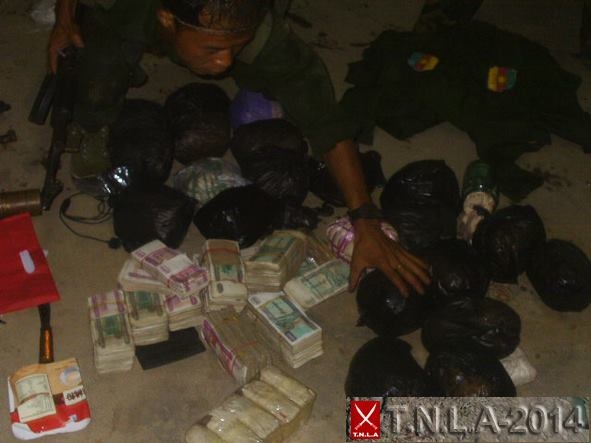
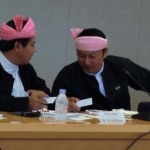
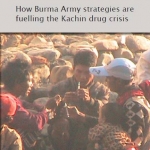
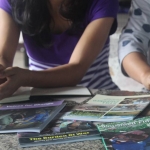
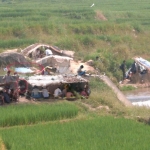
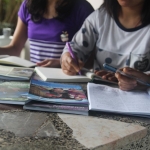
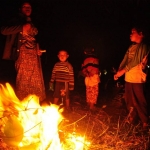
[…] There are 400,000 internally displaced persons (IDPs) on the Burma side of the border. There is a massive drug issue both in the camps (which causes domestic abuse) as well as throughout the ethnic areas which is […]